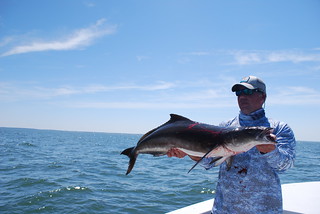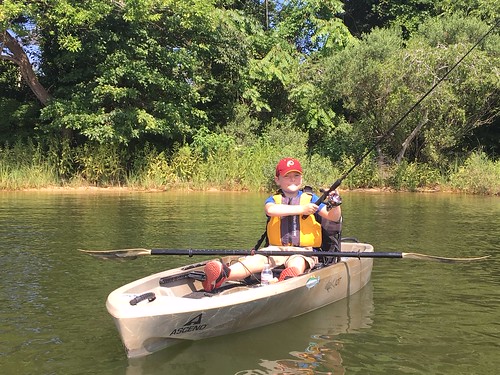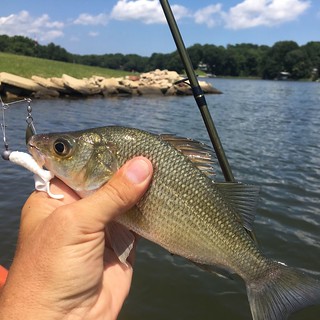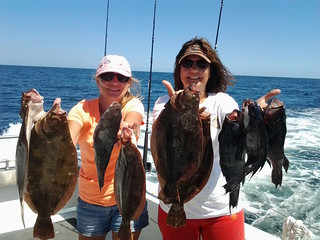Maryland Fishing Report – July 17
Summertime fun is settled in throughout Maryland. It’s great to see children whose parent, relative or guardian can take them fishing or crabbing, enjoying all that the Maryland outdoors has to offer.
Chesapeake Bay water temperatures are typically the warmest of the year during these last weeks of July. True to form, anglers will experience a week of very warm weather and water, with low winds and a chance of rain or thunderstorms Wednesday, and again Sunday through Tuesday. Bay gamefish will be holding in areas with adequate oxygen and the coolest water just above the “Don’t fish below this depth” line. Since rockfish will avoid water temperatures above 84 degrees, they are being squeezed into smaller areas. Recent Maryland Department of Natural Resources water monitoring indicates that the coolest, oxygenated water is found around Kent Island. The other way to find cooler water is to fish the shallows at first light, when surface water temperatures can be several degrees cooler.
Bay surface salinities are well below normal for this time of year, but improving slightly. In most of Maryland’s shallower bay waters, anglers will find adequate oxygen for gamefish from surface to bottom. However, to avoid low oxygen conditions in the deep channel waters from the Bay Bridge down to the state line and the lower Potomac River, avoid fishing deeper than 22 feet.
Water temperatures continue to increase towards peak levels. For the middle-to-upper bay — from Annapolis north — water temperatures are in the low 80s. Choptank area water temperatures have risen to the mid 80s. For the Potomac River at Point Lookout, surface water temperatures have risen to 83 degrees while water temperatures at Little Falls has risen to the mid 80s.
Expect average water clarity on most areas, with reduced clarity on the Nanticoke River, in Fishing Bay, and below the Susquehanna Flats on the western edge down to the Gunpowder River. On the Potomac River, expect reduced water clarity moving from Mallows Bay downriver to Colonial Beach. Expect normal flows from most Maryland’s rivers and streams. However, as a result of the potential thunderstorms Wednesday and again Sunday through Tuesday, there may be localized elevated flows. There will be above average tidal currents all week as a result of the full moon July 17.
For the full weekly fishing conditions summary and more detailed and up-to-date fishing conditions in your area of the bay, be sure to check out Click Before You Cast. You can now get regular updates on Maryland’s waters and the creatures that call them home sent to your inbox.
Striped Bass Summer Fishing Advisory Forecast:
Red: Air temperatures are forecast at 95 degrees or higher. Anglers are encouraged not to fish for striped bass after 10 a.m. and should target other species of fish.
Yellow: Air temperatures are forecast at 90-94 degrees. Anglers should use extreme care when fishing for striped bass; fish should be kept in the water when caught and released on these days.
Green: Fishing conditions are normal. Proper catch-and-release practices are encouraged.
More information about this awareness campaign can be found on the Striped Bass Fishing Advisory Forecast webpage.
The Conowingo Dam is on a serious power generation schedule during the day, which helps provide cool waters to the lower Susquehanna River area. There has been good topwater striped bass action in the river and along the outside edges of the Susquehanna Flats. The action tends to fall off as the sun rises and at that point casting 6-inch soft plastic jigs in white, chartreuse or pearl works well.
There is plenty of striped bass action around the Key Bridge, the Triple Buoys and Love and Podickory points. Most are live-lining a mix of spot and white perch along the 15-foot to 20-foot edges, while others are jigging with soft plastics. The best fishing is occurring in the early morning hours on a good tide, and tends to shut down as the day heats up.
There is still striped bass action at the east side of the Bay Bridge in less than 25 feet of water. Most are drifting soft crab or cut bait or live-lining spot and white perch back to the bridge piers along the 18-foot to 30-foot channel edges. Jigging right up close to the bridge piers is another good option. As with other locations the action tends to shut down as the day’s heat increases. A few are trolling along the main channel edges with a mix of hoses, spoons and bucktails with mixed results. Umbrella rigs are often a popular choice being pulled with heavy inline weights.
Fishing for white perch has been good on the upper bay over shoals and reefs in the main part of the bay from the Swan Point area south to the Sandy Point area. White perch can also be found along shoreline structure in the tidal rivers and creeks. Bottom rigs baited with pieces of bloodworm or grass shrimp work well in deeper waters. Casting small lures such as beetle spins works well along shoreline structure in the early morning and evening hours. Channel and blue catfish continue to be very common in the upper bay and its tidal rivers.
Live lining for striped bass is taking center stage, as spot are now readily available in most hard bottomed shallower areas. Remember that circle hooks are required for fishing with live fish or live eels. The Maryland Department of Natural Resources advises anglers to use circle hooks at least 8/0 in size to minimize deep-hooking. Check our website and video for more information on circle hooks and careful release.
The outside edge of Hacketts Bar, Thomas Point, Bloody Point, the edge at Gum Thickets and some of the channel edges in Eastern Bay are producing fish. A good tide is important and the action tends to slow down by late morning due to heat.
Jigging at the above channel edges is a viable option or wherever suspended fish can be spotted on depth finders. Trolling has been slow in most areas of the middle bay region. The shallow water striped bass fishery in the lower sections of the tidal rivers continues to be disappointing with only marginal action before sunup and sun down. Topwater lures are being used over grass and swimshads and crankbaits near deeper shoreline structure.
Many have moved towards fishing for white perch in the tidal rivers. Casting small lures and beetle spins along shoreline structure in the early morning or evening hours can provide a lot of fun and some large white perch. Bill Burton Fishing Pier State Park has been a popular location to fish for white perch using bottom rigs and pieces of bloodworm. Catfish and spot are also common there.

Travis Long could not wait any longer and ventured south to catch this nice cobia. Photo by Keith Lockwood
Now that spot are so common and spread throughout the region, live-lining has become the premier way to fish for striped bass. The steep channel edge from Piney Point to St. Georges Island in the lower Potomac River and the edges near Point lookout have been the best places to fish. A few enterprising souls are jigging in these same locations or finding small pods of fish suspended along channel edges in the lower Patuxent River and other locations.
Trolling is an option but very few striped bass are being caught that way – most are now targeting Spanish mackerel. The best trolling action for Spanish mackerel and small bluefish has been from the Middle Grounds area east into the Pocomoke and Tangier Sound area. Salinity values are a bit higher on the eastern side of the bay.
There have been a few reports of cobia in the vicinity of the Target Ship but the bulk of the cobia action remains far south in Virginia waters. Once again the eastern side of the bay near Pocomoke Sound would offer the best chances of spotting a cobia swimming near the surface. Casting live eels and large soft plastics in pink tend to be the preferred methods to target them. Getting up high for a better view with Polaroid-lensed sunglasses are a must. More than a few Maryland boats with large gas tanks have been making the run south in search of cobia. If one cannot wait for the fish to come to them, then that seems to be the best way to go.
Bottom fishing has been excellent for a mix of spot, white perch and small croaker. The spot are packed in the lower Potomac and Patuxent rivers — about half are eating size and half suitable for live-lining. The croaker are marginal in size but the white perch are large and there are plenty of them. Pieces of bloodworm or wild shrimp are good baits to use over hard bottom. Blue catfish are becoming less of a problem in the lower Potomac and Patuxent lately; they seem to be moving farther up the rivers. Bottom fishing for the above species has been excellent in the Pocomoke and Tangier Sound areas.
Warm water conditions seem to be having an effect on recreational crabbing success, which has dropped off in the last couple of days. The best and largest crabs are coming from 12 feet to 15 feet of water, and the shallower areas tend to be full of smaller crabs. There has been some very active shedding going on in the past week and crabbers are seeing quite a few 7-inch crabs that have just shed, they are very light and if just given another week or so will fill out to be a nice heavy jumbo crab. Razor clams continue to reign in regards to preferred bait, while chicken necks are a distant second. The middle bay area has been a good place to crab and it has been interesting to see commercial boats from the lower bay trot-lining in this area recently.
In the far western region of the state, vacationers at Deep Creek Lake are enjoying some good, lazy summer fishing. Most anglers are drifting along deep grass edges and using minnows to catch a mix of yellow perch, smallmouth bass, chain pickerel, and the occasional walleye. Those looking for largemouth bass are working floating docks and fallen treetops with a variety of soft plastics and crankbaits. Thick grass is also a good target for dropping soft plastics down through the cover. Along the dam face, trout and walleye can be found down deep by slow trolling nightcrawlers or minnows.
The upper Potomac has calmed down but one must keep a watch for rising water levels due to heavy runoff from rain storms. The larger smallmouth bass can be found in the deeper holes and riffles. Small crankbaits and grubs tend to be the best baits to use. Topwater lures can offer some fun smallmouth bass fishing in the pre-dawn hours.

Jordan Bradshaw caught this fine looking crappie in Loch Raven Reservoir. Photo courtesy of Jordan Bradshaw
Trout fishing is now a fly fisherman’s world for the most part. Working nymphs or terrestrials in the western and central region trout management waters offers some calm and peaceful fishing. Many of the tail race waters such as the North Branch of the Potomac, the Savage, the Youghiogheny and the upper Gunpowder are running cool and fast due to water releases, which make for fine trout fishing. The trout tend to spread out and feed actively.
The tidal Potomac River is locked into a summer mode of fish behavior, which means fishing early morning and late evening hours are the best largemouth bass fishing opportunities. Casting buzzbaits and frogs into shallow grass is a fun way to fish for largemouth bass and the occasional northern snakehead. The snakeheads can be found far back in thick grassy areas where heat and the lack of oxygen tend to keep away species such as largemouth bass. Later in the day largemouth bass will be found sulking under thick grass in deeper areas avoiding the sun and warmer water temperatures. Dropping stick worms or soft plastics down through the thick grass can entice a pickup.
The same scenario plays out in the many ponds and reservoirs that dot the Maryland landscape. Largemouth bass are active during the night and tend to rest wherever they can find shade and cool water during the day. Creek mouths and springs are always go to places to look.
Crappie have moved into deeper waters near any structure they can find. In tidal waters, marina docks are a good place to fish with minnows or small jigs under a slip bobber. Fallen treetops in lakes or tidal rivers are a good place to look if the water is deep, and bridge piers offer them both structure and shade. Bluegill sunfish are very active during the summer months and can offer a lot of action. The younger set can stick to worms or crickets under a bobber, while beetle spins are a fun way to fish for those that can cast. For aspiring fly fishermen, nothing beats casting small poppers, foam ants or hoppers near lily pads for some summer fun.
The Ocean City area offers a wide variety of fishing opportunities for vacationers this week. Surf fishermen are seeing the best catches of kingfish in the morning hours before bright sunlight and warming waters tend to drive them out of casting range. Pieces of bloodworm have been the favored bait. Small bluefish are being caught on finger mullet and a few croaker; blowfish and flounder are being caught on squid.
At the inlet and Route 50 Bridge area, small bluefish continue to move into the inlet on a flood tide and are being caught by casting metal, Got-Cha lures and bucktails. Flounder are present in good numbers and can be caught from shore by casting and bouncing Gulp baits or squid along the bottom.
The back bay channels are holding flounder – slow-trolling or drifting is a good way to catch them. The Thorofare and East Channel are good places to fish but large boat traffic can be an issue during the morning and late afternoon. Sinepuxent Bay offers less boat traffic and great flounder fishing out in front of the airport.
Outside the inlet, those trolling a mix of spoons and hoses are catching bluefish and Spanish mackerel along the shoal areas and beyond. Sea bass fishing has had its ups and downs, which is typical for summer. Most days, catches are decent with a mix of flounder and other species.
The boats heading out to the canyons and trolling are coming back to the docks with a mix of larger yellowfin tuna, a few Bluefin and bigeye tuna. White and blue marlin releases are fairly common and catches of large gaffer size dolphin have been very good.
The boats heading out to the canyons and trolling are coming back to the docks with a mix of larger yellowfin tuna, a few Bluefin and bigeye tuna. White and blue marlin releases are fairly common and catches of large gaffer size dolphin have been very good.
“Angling is extremely time consuming. That’s sort of the whole point.” — Thomas McGuane
Maryland Fishing Report is written and compiled by Keith Lockwood, Maryland Department of Natural Resources fisheries biologist.
Click Before You Cast is written by Tidewater Ecosystem Assessment Director Tom Parham.
This report is now available on your Amazon Echo device — just ask Alexa to “open Maryland Fishing Report.”






